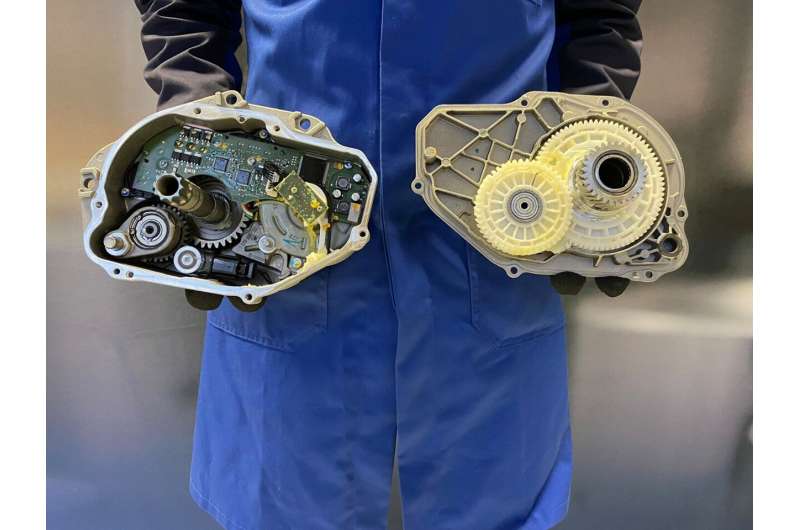
An increasing number of people are riding electric bikes. Compared to cars, electric bikes are cheaper, more environmentally friendly, healthier for every-one and free up space in urban areas. The drawback is that there are often no spare parts for defective components such as motors or batteries, meaning they have to be completely replaced with expensive new components.
A team of researchers from the Fraunhofer Institute for Manufacturing Engineering and Automation IPA demonstrated in a study with its partners that electric bike motors can be remanufactured in keeping with the concept of a modern circular economy. The researchers at Fraunhofer IPA will provide insight into the remanufacturing of electric bike components in the RemanLab, a new learning environment for remanufacturing.
The popularity of electric bikes continues to grow—according to the German Bicycle Industry Association (ZIV), electric bikes accounted for 48 percent of sales across the entire bicycle market in 2022—and this figure is set to increase in future. The choice of models is also becoming more diverse. Alongside well-known brands, small manufacturers, too, are bringing new products to the market. However, especially in the case of batteries and motors, it is often technically and economically unfeasible to be repaired in the workshop. Thus, the failure of a component of an electric bike may result in a total loss.
Why not industrially remanufacture the used electric bike motors? Researchers at Fraunhofer IPA asked themselves that very question as part of the AddRE-Mo project. Together with partners from cirp GmbH, Electric Bike Solutions GmbH, the sponsoring association Cluster of Environmental Technologies Bavaria e. V. and the Wuppertal Institute for Climate, Environment and Energy, they explored the technical feasibility of remanufacturing electric bike motors.
This involved taking a close look at the entire remanufacturing process chain—from non-destructive disassembly to cleaning, testing, reconditioning and finally reassembly—and analyzing its ecological and economic potential. What’s more, the researchers wanted to test the use of additive manufacturing processes and suitable combinations of processes and materials to produce long-lasting and reliable spare parts.
From disassembly to reassembly
“If the motor or battery fails, it’s usually the case that the entire component is replaced, even though it may only be one gear that’s faulty. It is rarely worthwhile for electric bike workshops to repair a motor or battery, and manufacturers also have a vested interest in replacing old motors, which are the biggest cost drivers in electric bikes, with new ones,” says Jan Koller, project manager and group leader at Fraunhofer IPA, describing the dilemma.
“Our goal was to implement a value retention network by establishing an industrial remanufacturing process where a large number of motors (between 50 and 100) go through the process.”
The first step for Koller and his team was to examine electric bike motors from established manufacturers to determine their probability of failure. Then they investigated whether and under what conditions spare parts with a high wear rate, such as gears and torque supports, could be additively manufactured.
The scientists gathered the necessary data for additive manufacturing either through 3D modeling or 3D digitization, depending on the geometry of the components. They then selected materials and additive processes. Finally, together with the companies cirp and Electric Bike Solutions, Fraunhofer IPA manufactured the components and tested their service life, noise emission and temperature resistance on purpose-developed test benches and under real loads.
A total of over 120 components were produced from 20 different materials using 3D printers. High-speed sintering, a special process for manufacturing or modifying materials, proved particularly promising when used in combination with the plastic polyamide 12 (PA12). The project results are summarized in the study “Additive Refabrikation in der Elektrofahrradbranche” (Additive remanufacturing in the electric bike industry), which is available for download free of charge.
The project partners were able to demonstrate technical feasibility and durability through reassembly and testing under real operating conditions. The research results showed that individual components such as gear wheels can be manufactured additively and used sustainably. “At the end of the process chain, remanufacturing delivers a bike motor that is on par with a newly manufactured motor in terms of quality, and also comes with the same guarantee,” Koller explains.
Resource efficiency and sustainability through additive remanufacturing
Another important factor was the ecological evaluation of the remanufacturing process relative to brand new production. “Additive manufacturing has the potential to improve circularity in the electric bike industry and reduce resource wastage. A kilogram CO2 equivalent saving of 90 percent can be achieved in comparison with brand new production,” says the industrial engineer.
The economic savings potential, on the other hand, depends on the number of units and is usually around 30 to 40 percent for comparable components as compared to buying a new electric motor.” Consequently, remanufacturing also harbors great potential for manufacturers of electric motors.
RemanLab learning environment to open its doors in Bayreuth
To perpetuate the achievements of this project, the process chain for remanufacturing electric bike motors will be implemented and demonstrated in the new RemanLab learning environment for remanufacturing at Fraunhofer IPA in Bayreuth. The RemanLab will open on May 23, 2023. In this realistic learning environment, which features all the necessary test benches, companies will gain an insight into the future of sustainable production.
Electric bike motors will be used to impart knowledge about the complexity of the remanufacturing process, from entrance diagnosis to disassembly, cleaning, testing, reconditioning, reassembly and final inspection, with the aid of demonstrators such as an augmented reality application for disassembly.
“Up to this point, remanufacturing has been characterized by cost- and labor-intensive processes. In the RemanLab, we will demonstrate how digital technologies and automation can revolutionize remanufacturing not only of electric motors, but also of small electrical appliances and other products in the future,” says Koller.